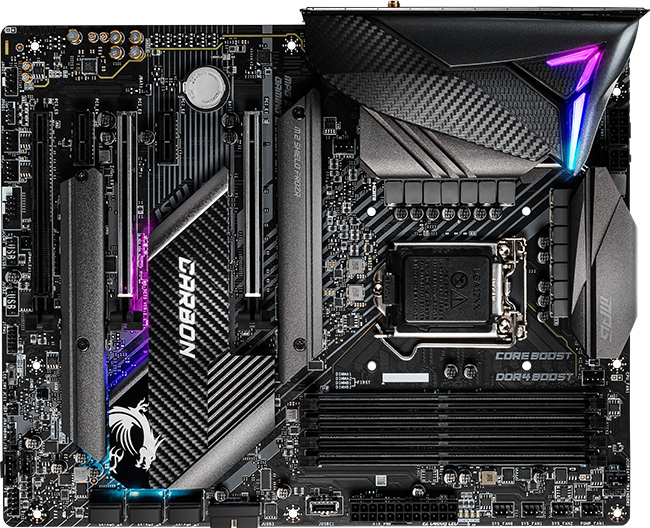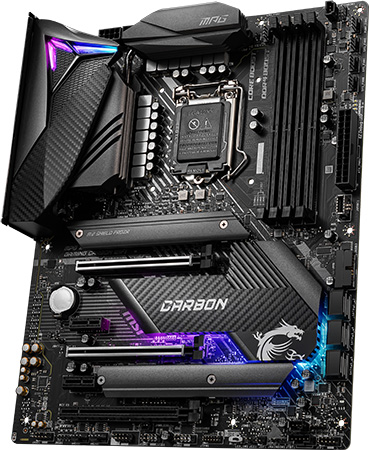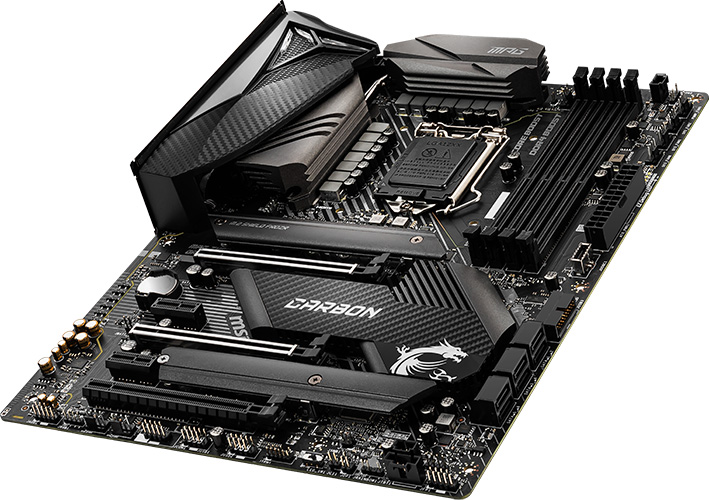Today marks and important day in the diary of desktop motherboard makers because Intel is releasing 24 processors based on 10th Gen Core technology. Important for the fortunes of motherboards makers because they require a new socket layout known as LGA1200 and, consequently, support from all-new 400-series chipsets, MSI is ready to go with 10 boards harnessing the Z490 chipset.
Intel hasn't divulged the performance Z490 chipset in any great detail, though we know it's very similar to incumbent Z390, and more details will be shared at a later date. Nevertheless, we've secured the MSI MPG Z490 Gaming Carbon WiFi for review and today represents the first opportunity for it to break official cover.
Whilst no performance numbers can be published for a while, we can still ascertain what changes MSI has made between generations, so let's take a closer look.
The ATX-sized Gaming Carbon WiFi has always been a good seller through generations as it employs a number of manufacturer-specific features without breaking the bank. It sits below the Z490 Godlike, Ace, Unify models but above the Gaming Edge, Tomahawk, Gaming Plus, and plain old Pro in the pecking order. The equivalent Z390 model is available for around £200; this one tips the scales at £250 or so, which is to be expected as it heralds in a new chipset.
Cooling around the socket appears the same as the last generation, with a large, integrated I/O shield obscuring the heatpipe-connected heatsinks. Power is sourced from a 12-phase supply, plus an additional two for the memory, and there's the same amount of room around the CPU socket. Remember you can use existing LGA1151 coolers here, too.
Gone are the strengthened DDR4 slots, but MSI says official support now scales from DDR4-4400 to DDR4-4800, hinting at good overclocking possibilities for Z490.
The standard ATX board now features proper heatsinks for both available M.2 slots. They're the same distance apart as on Z390, and both sport PCIe 3.0 x4. It's a shame that a £250 board doesn't have a third slot, though the blame for that has to fall at Intel's door because of restricted lane usage.
Upper RGB lighting is the same but the lower half has been moved to under the chipset rather than a strip running down one side of the rear; we reckon it looks better this way because it ought to provide more even lighting in your case. A three-slot PCIe x16 arrangement remains, catering for two-way SLI or three-way CrossFire, but do remember that lane limitations rear their head by imposing x8/x8/x4 if all three are filled. As before, the top slot is connected directly to the CPU's lanes whilst the lower two pull theirs from the chipset.
MSI has taken the opportunity to beef up high-speed connectivity support. Whereas the Z390 variant has 5x USB 3.1 G2 (10Gbps), 4x 3.1 G1 (5Gbps) and 6x 2.0 (480Mbps), Z490 adds a single USB 3.2 G2 2x2 offering the full 20Gbps, a further 5x 3.2 G2 (10Gbps, same speed, different name), 2x 3.1 G2 (5Gbps), and the usual 6x 2.0. Phew.
Gigabit LAN is replaced by 2.5G from Realtek, which you will find on every Z490 from MSI's stable. The same can be said for front-panel Type-C which support for the latest chassis.WiFi, meanwhile, uses the newer Intel AX201 chipset instead of AC-9560, raising peak speeds from 1.73Gbps to 2.4Gbps. All good, incremental improvements.
It's no surprise to find the I/O panel remaining similar through generations. The USB Type-C port caters for that faster 20Gbps speed and there's one more USB Type-A port, too. Other than that, it's good to see MSI still retain DisplayPort and HDMI outputs for those running Core processors with integrated graphics.
Appreciating the £250 price point, common sense tells us that it ought to be paired with a processor costing at least as much, preferably unlocked for maximum performance. To that end, the Core i5-10600K ought to be a good bedfellow.
In summary, MSI opts for a general redesign for its popular MPG Z490 Gaming Carbon WiFi motherboard. Better M.2 cooling, higher ratified memory speeds, relocated RGB lighting, the provision of 20Gbps USB, and faster Ethernet mark out the key improvements from the previous generation. Stay tuned for our full review later on next month.











